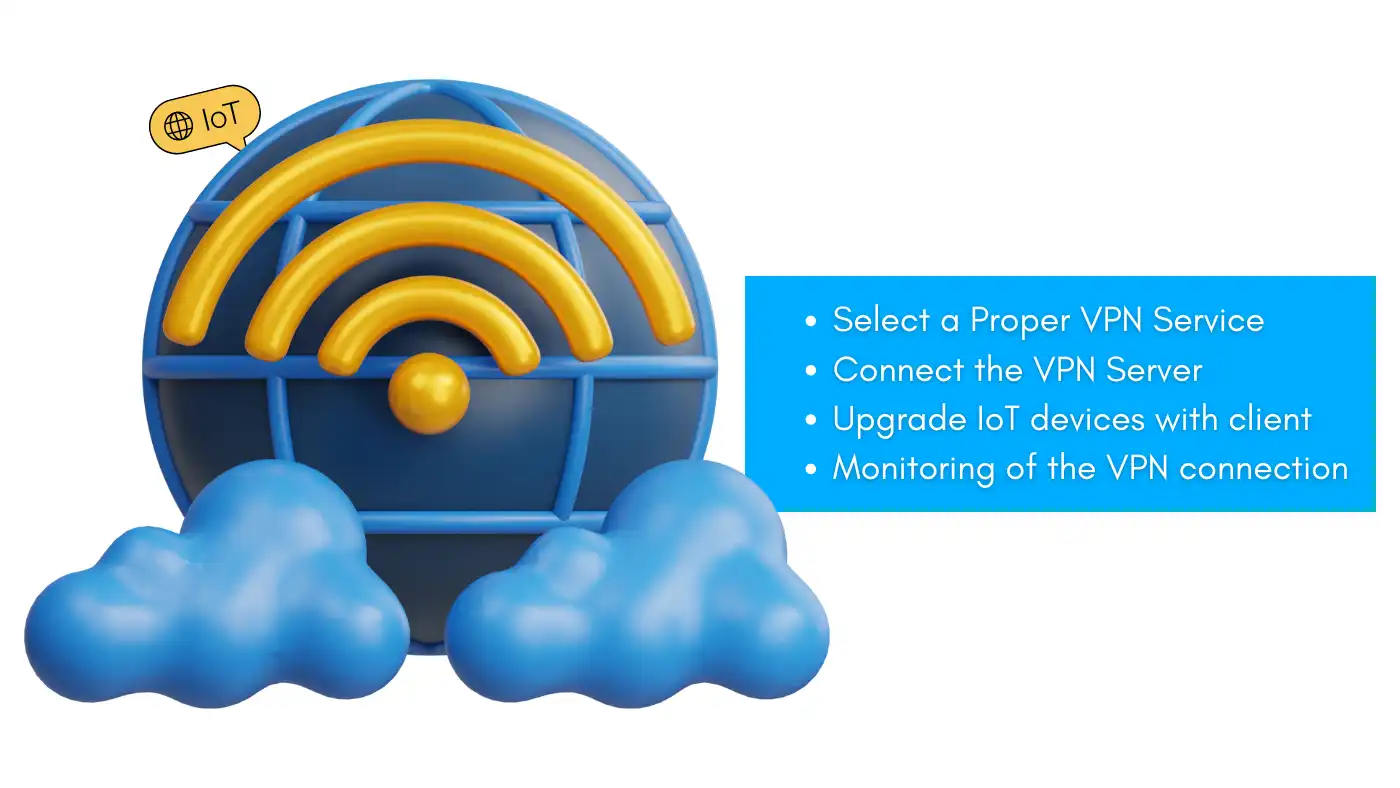It is critical to protect your IoT devices, especially with the current exponential rise in the number of connected devices.
Since most IoT devices are net-connected and transmit confidential information over the internet, they rank as primary cyber victims.
A VPN for IoT devices is the right solution to improve the security of such gadgets by providing encryption of the messages exchanged between the devices and the formation of secure channels of communication.
With a VPN for IoT devices in place, the IoT devices can be safeguarded from unauthorized control.
And the applications are afforded protection against a lot of threats like the man-in-the-middle type of attacks to name but a few, as well as being offered secure and convenient remote access to the devices.
This introduction explains why everyone should consider the protection of their IoT network by using a VPN and the ways to do so efficiently.
Role Of VPNs In IoT Security

Through the introduction and popularization of IoT into people’s daily lives and various industries, people have enjoyed convenience and efficiency.
However, this brings enhanced connection vulnerabilities in these devices’ security.
Which makes VPN for IoT security vital in protecting these devices. Here are the key aspects of how VPNs enhance IoT security:
1. Data Encryption
Choose a VPN for IoT security that helps to encrypt the data shared over the Internet of Things devices with the help of the internet, ensuring no personal data is shared with a third party without permission.
This encryption is crucial in the prevention of intercepting data in transmission.
2. Secure Remote Access
VPNs help to provide secure access to IoT devices to allow consumers to control the devices regardless of their geographical location.
This is quite advantageous to organizations that are required to manage IoT devices but cannot be physically present. A VPN for internet of things devices enables this secure control across any distance.
3. Privacy Protection
Due to the ability of VPNs to hide the actual IP address of the IoT devices, it offers privacy to users.
This means that malware cannot easily monitor device activities or even their physical location and therefore adds an element of secrecy to IoT business.
Using a VPN for internet of things devices ensures that privacy is maintained at all times.
4. Protection Against Cyber Threats
VPNs comprise a safe passage through which data transfer takes place, helping protect IoT devices with VPN from various cyber risks such as MITM and DDoS attacks.
This secure channel helps guard against attackers who may be relaying the data, or altering it in their way.
5. Network Segmentation
Through VPNs, an organization can restrict IoT devices to different classes of networks. This minimizes the attack surface and lowers the ability of an attacker to penetrate deeper into other devices or other data on the main network, thus offering another way to protect IoT devices with VPN technology.
6. Compliance with Regulatory Standards
There are so many rules for data privacy and protection in so many sectors across the world. IoT VPN security solutions are useful to organizations in meeting compliance needs by enabling secure IoT devices’ connectivity as well as the protection of data.
7. Multi-Path Protection
The best IoT VPN security solutions are known to incorporate multi-path protection, which helps make connections more reliable while at the same time improving IoT devices’ performance and offloading end-to-end encryption within the network.
8. Control on the Internet use
By doing so, IoT devices are protected by the layer of a VPN meaning that they shall not directly connect to the internet. This reduces the exposure to risks where the common aim is to target a device that has been placed on the internet.
9. Authentication of Devices
VPN isolates each internet-connected IoT device through authentication before their connection to the network, ensuring IoT device security with VPN. Only authorized devices can access information resources within the network.
10. Improved Security for Low Power Devices
Many IoT devices, especially those of low power such as sensors and trackers, do not have very well-developed security procedures.
IoT device security with VPN helps in protecting these risky gadgets to the extent that is possible.
11. Flexibility in Deployment
VPN solutions are available in several deployment options, including routers with built-in VPN for IoT devices and cloud-based deployment, making it easier for organizations to address different needs they have in the protection of IoT devices.
12. Scalability
When it comes to growing IoT networks, VPN for IoT devices doesn’t have to change its setup much, allowing organizations to simply add more devices and improve the safety of the network.
13. Robust Customer Support
The best VPN service providers with dependable customer care provisions guarantee that organizations can easily get the assistance they need in case of any problem with the security of their IoT devices.
14. Regular Updates and Maintenance
Most VPN service providers regularly release updates to the software as a way of dealing with the loopholes whilst providing security for the IoT devices.
15. Cost-Effectiveness
The use of a VPN can also be a reliable low-cost security strategy in comparison with the other security approaches, particularly if the company uses numerous IoT devices.
16. Effectiveness in Integrating with Other Current Security Solutions
They are effective in enhancing the security of other layers of security like firewalls and intrusion detection systems to offer security to IoT devices.
A VPN for IoT devices can further enhance this protection by securing communications between these devices and the broader network.
17. User Education and Awareness
The utilization of a VPN for IoT devices ensures that organizations have to set up campaigns to ensure that individuals who will use the IoT devices are fully aware of the existing security risks.
18. Future-Proofing IoT Security
So, with growing IoT technology, the VPN can also embrace changes in security issues, thus keeping organizations safe from new hosts.
19. Support for Multiple Protocols
Most of the VPNs go with many tunneling protocols, for example, OpenVPN as well as IPSec which make the connection of IoT devices flexible in terms of security.
20. Enhanced Device Management
VPNs help in the management of IoT devices by allowing their configuration to be accessed securely thereby allowing their administrators to maintain the best security standards for the devices.
Therefore, the analysis supports the role that VPNs have to offer in the protection of IoT devices mainly through the provision of an encrypted space, privacy, and a secure method of remote access.
Thus, the utilization of VPN technology is going to be critical as more Internet of Things products develop and connect.

- Lightning-fast speeds to browse without lag
- Servers in 105+ countries around the globe
- Military-grade security to stay safe online
- Try it risk-free with its money-back guarantee
- Native apps for all major devices
Major IoT Cybersecurity Concerns

Here are some of the major IoT cybersecurity concerns:
Expanded Attack Surface
However, as the number of IoT devices is increasing at a fast pace, so does the attack vector. The world is now heading toward the Internet of Things where billions of devices can get connected and unfortunately, hackers have more doors to open.
Insecure Hardware
Several IoT devices are not incorporated with security measures since it cannot be done at the hardware level.
Besides, these devices have other issues such as using weak passwords, often lacking any form of authentication, failing to add strong letters in passwords, and having very little encryption prowess.
Maintenance and Update Challenges
It is very challenging to ensure that IoT devices are updated with the latest security patches. Even vendors may delay the deliveries of updates and discrete devices can prematurely be isolated from the internet or turned off in general, thus refusing essential security patches.
Lack of Device Visibility
It becomes so hard for organizations to keep track of all the IoT devices connected to their networks. Due to a lack of insight into the devices and the data they process, it is almost impossible to decide on what risk is present and/or the right security measures to put in place.
Data Privacy Concerns
The IoT devices firmly gather and transmit enormous measures of delicate data. The lack of stringent security measures to protect this data made it vulnerable to being hacked or stolen by bad actors.
Potential for Physical Damage
It is a known fact that many IoT systems govern the essential facilities inclusive of building security, electrical power, and industrial equipment.
These systems, therefore, pose the risk of compromise of physical infrastructure, operational disruption, and threats to safety.
Lack of Security Standards
By having numerous players involved in the IoT architecture, the IoT ecosystem has not had a clear standard security infrastructure for organizations to aim for thereby allowing any kind of devices into the network.
How To Connect IoT Devices To A VPN

IoT device connection to the VPN is widely needed to improve the security level and shield critical information. Here’s a step-by-step guide on how to achieve this:
1. Select a Proper VPN Service
Choose a VPN provider that caters to the IoT platform as well as IoT devices through strong encryption, and device authentication among others.
OpenVPN and Telenor IoT are some of the well-known service providers going by this aspect due to their security.
2. Connect the VPN Server
- On-Premises or Cloud: Choose between configuring the VPN server on your premises or employing the cloud as the host for this server. A surprising number of IoT platforms include VPN support as a standard feature of the ‘platform’.
- Configuration: To configure the VPN server, the provider’s instructions should be fulfilled to guarantee the server supports device-compatible protocols.
3. Upgrade IoT devices with client
- Check Compatibility: Make sure that the IoT devices can support the running of a VPN client. Certain gadgets may call for unique firmware or certain operating systems that allow the use of VPNs.
- Install the Client: In case your device allows it, then proceed and download the VPN client software. This may include app download where a particular VPN application needs to be downloaded and installed or change the settings where the user may need to tweak the device setting to establish VPNs.
4. Configure VPN Settings
- Authentication: Used, create an authentication method for the IoT devices that are being used. This may involve the employment of certificates, usernames, and passwords which would help in completing the list of apparatus, only to allow the VPN to be accessed by approved apparatus.
- Encryption Settings: Select the proper encryption level of data transmission, e.g. Advanced Encryption Standard (AES) 256.
5. Bring IoT Devices into the VPN
- Network Configuration: A proper way to ensure that your IoT devices are accessing the VPN is by setting this configuration on the network layer. These could be the VPN server address, Port numbers or maybe any authentication details that may be required.
- Testing the Connection: Once the configuration is done you should check that the IoT devices can both send and receive over the VPN. One’s utilization of tools to ensure what enters or is transmitted over the network is encrypted and to ensure that the devices are authentic.
6. Monitoring of the VPN connection.
- Regular Updates: Ensure that the VPN client and server are up-to-date to reduce vulnerability.
- Monitoring Tools: Implement and use the monitoring tools for assessing the efficiency and the condition of the connection as well as checking the status of all connected devices for their security.
Factors To Consider When Choosing A VPN Provider


Uninterrupted, high-speed browsing, zero logs so your online activity is always private.
Over 7000 people checked out NordVPN in the last month
So, several signs should be taken into account while selecting a VPN provider, to choose a service that will be appropriately secure, fast, and intuitive.
1. Purpose and Use Case
List down your main beliefs about relying on a VPN connection. It would be to determine the level of security needed, to avoid restrictions towards streaming services, or even establish secure connections for work purposes from distant locations, identifying your goals will assist in eliminating theanted risks.
2. Security and Privacy Features
- Encryption: Ensure that the encryption is standard and proper with the view emphasis laid on Advanced Encryption Standard – AES 256.
- No-Logs Policy: Select a provider that has a clear no-logs policy meaning that your online activities will not be logged.
- Kill Switch: This feature terminates your internet connection if the VPN connection is lost in good data flow through your regular connection.
- DNS Leak Protection: Guarantees that all your DNS requests are channeled through the VPN to ensure
3. Server Network and Locations
They are faster with network coverage which enables one to access geo-restricted content albeit with a larger number of servers. It will be reasonable to choose a provider that operates from the areas that are of interest to your needs.
4. Connection Speed
VPN may reduce your internet speed. Choose a provider that has fast servers and a low extent of speed reduction for streaming and downloading.
5. Device Compatibility
Confirm that all your targeted operating systems are supported including Windows, Mac OS X, Android, iOs, and routers. Some of the providers also have browser extensions.
6. Simultaneous Connections
Find out the number of devices allowed to be connected at a go using one subscription. This is advantageous, especially for multiple users or multiple devices in a given household.
7. Customer Support
Help-desk service is an essential factor to be considered.
While selecting the needed service look for providers that can guarantee fast and helpful responses through live chat, email, or phone.
8. Ease of Use
The web interface must be structured and intuitive, setup notes are a problem for people who are not computer literate.
9. Price and Payment Options
Analyzing the last two factors, one should address such questions as what kind of pricing is used, and which payment options are possible.
First, consider the price and services that come with the guarantee of a refund, or free trial period so that one can sample the service.
10. Reputation and Reviews
Check more data, such as friends’ or relatives’ experience, independent forums, and consult specialized sites to see more about the provider’s credibility. Never use a free VPN service as most of them are not that secure and can compromise the consumer’s privacy.
Latest Articles On VPN For The Protection Of IoT Appliances
Zipit Wireless discusses the advantages of using VPN for IoT.
The company, Zipit Wireless, came out with a guide that could help protect IoT devices from cyber threats, particularly through VPN.
He also notes that a VPN for IoT devices ensures that data is encrypted and the devices to be connected are authenticated, thus adding another layer of security.
It also talks about updating VPN software from time to time to prevent the vice from penetrating through and compromising communication between devices.
ExpressVPN rolls out IoT Device Protection capabilities.
Other functions that have been formulated and implemented in the VPN include the shielding of IoT devices including smart home appliances.
More specifically, the router can be equipped with a VPN which means that all devices connected to the router will also be protected against any unauthorized interception or snooping.
The setup process is simple so it becomes easy to apply VPN protection across all the gadgets.
Case Studies On How To Secure IoT Devices With A VPN
The first case study is Smart Home Security :
Scenario: A homeowner’s home consists of many connected smart devices such as security cameras, smart door locks, and smart thermostats among others.
Solution: In this case, the homeowner ensures that there is a VPN-enabled router to enhance the security of all connected devices. When the data is transmitted via a smart device, such as a laptop, or a smartphone to the cloud, this is protected with a VPN making it almost impossible to hack into such a connection. The VPN also conceals the IP addresses from the devices making it more secure to use.
Outcome: The homeowner gets relieved when they are sure that the smart home devices are safe from cyber threats and that they can control or monitor the home from anywhere securely.
The second case concerns the deployment of Industrial IoT
Scenario: A manufacturing firm utilizes IoT sensors for sensing equipment utilization and their performance to make assessments for maintaining such equipment.
Solution: The company uses a site-to-site VPN to establish a secure connection between the IoT devices as well as the corporate network. This VPN utilizes a public key cryptography method to encrypt information being transferred from device one to another while at the same ensuring operational data is kept secure.
Outcome: The company effectively manages to protect its data and avoid intrusion of the industrial IoT so that it is safe to get important data and analyze it without disturbing the safety aspect.
The third real-life case relates to the Internet of Things devices in the healthcare context.
Scenario: A healthcare provider employs IoT technology in the remote tracking of the patient’s vital signs.
Solution: To enhance the security of the connection between the IoT monitoring devices and the healthcare system, the provider uses a VPN. The VPN encodes the patient information which complies with laws such as HIPAA in the healthcare sector.
Outcome: It also helps in maintaining the patients’ information secure and private during the transfer of data hence doctor or any healthcare provider is trusted by the patients and the public.
FAQs
What is a VPN and how does it secure IoT devices?
Why it is necessary to use a VPN to secure IoT devices?
How can I configure the use of VPN to my IoT devices?
What are the factors to be considered in selecting a VPN?
Is it possible that by using a VPN my IoT devices will slow down?
Conclusion:
Therefore, if you are involved in an IoT network or planning to be involved in one, making sure the devices are secure with a VPN for IoT devices should be on your to-do list.
Especially given the things that can go wrong in a connected world.
Through connecting your devices and the Web, a VPN does not allow different unauthorized users to enter and keeps your data safe from hackers.
Smart home devices, Industrial IoT sensors, connected healthcare monitors – no matter what you’re utilizing, a VPN comes in handy.
Because the VPN will be used at the router level, all IoT devices connected to your network will be protected and you will suffer less in the face of constant change in security threats.






